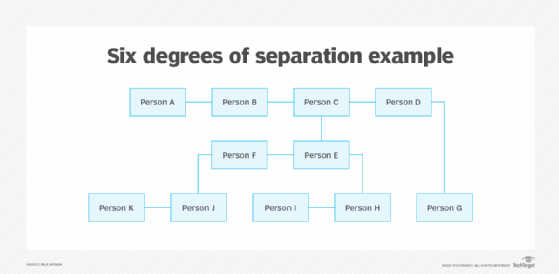six degrees of separation
What is six degrees of separation?
Six degrees of separation is the theory that any person on the planet can be connected to any other person on the planet through a chain of acquaintances that has no more than five intermediaries.
The concept of six degrees of separation is often represented by a graph database, a type of NoSQL database that uses graph theory to store, map and query relationships. Real-world applications of the theory include power grid mapping and analysis, disease transmission mapping and analysis, computer circuitry design and search engine ranking.
How does six degrees of separation work?
Figure 1 provides a basic illustration of how six degrees of separation works. Person A would get a message to Person K by taking the following six steps:
- Person A to Person B
- Person B to Person C
- Person C to Person E
- Person E to Person F
- Person F to Person J
- Person J to Person K
With the help of five intermediaries, the mission is accomplished.

Early development of the six degrees of separation concept
The six degrees of separation theory was first proposed in 1929 by the Hungarian writer Frigyes Karinthy in a short story called "Chains."
In the 1950s, Ithiel de Sola Pool, a professor at Massachusetts Institute of Technology, and Manfred Kochen, a research mathematician at IBM Thomas J. Watson Research Laboratory, set out to prove the theory mathematically. They were able to phrase the question mathematically: Given a set N of people, what is the probability that each member of N is connected to another member via k_1, k_2, k_3 ... k_n links? However, after twenty years they were still unable to solve the problem to their satisfaction.
Testing six degrees of separation
In 1967, American sociologist Stanley Milgram devised a new way to test the theory, which he called "the small-world problem." Milgram randomly selected people in Kansas and Nebraska to send packages to a stranger in Boston. The senders knew the recipient's name, occupation and general location. Each participant was instructed to send the package to a person he knew on a first-name basis who was most likely, out of all the participant's friends, to know the target personally. That person would do the same, and so on until the package was personally delivered to its target recipient.
Although participants in the small-world experiment expected the chain to include at least a hundred intermediaries, it only took on average between five and seven intermediaries for each package to be delivered successfully. Milgram's findings of the small-world project were published in Psychology Today and inspired the phrase "six degrees of separation." Playwright John Guare popularized the phrase when he chose it as the title for his 1990 play.
Milgram's findings were discounted after it was discovered he had based his conclusion on a small number of packages. However, six degrees of separation became an accepted notion in popular culture after Brett C. Tjaden published a computer game on the University of Virginia's website based on the small-world problem.
Tjaden used the Internet Movie Database to document connections between different actors in Hollywood. The game asked website visitors to guess the number of connections between the actor Kevin Bacon and any other actor in the data set, and it was called The Oracle of Bacon at Virginia. Time magazine selected it as one of the "Ten Best Websites of 1996."
Later research on six degrees of separation
In 2001, Duncan Watts, a professor at Columbia University, continued his earlier research into the phenomenon and recreated Milgram's experiment on the internet. Watts used an email message as the "package" that needed to be delivered. Surprisingly, after reviewing the data collected by 48,000 senders and 19 targets in 157 countries, he found that the average number of intermediaries was indeed six.
In 2008, Microsoft attempted to validate the experiment by analyzing the minimum chain length it would take to connect 180 billion different pairs of users in the Microsoft Messenger database. According to Microsoft's finding, the average chain length was 6.6 hops.
In 2016, researchers at Facebook reported that the social media and networking site had reduced the chain length of Facebook users to three and a half degrees of separation. Dutch mathematician Edsger Dijkstra is credited with developing the algorithm in 1956 that made it possible for Facebook researchers and others to find the shortest path between two nodes in a graph database.
Learn more about graph databases and six degrees of separation.
